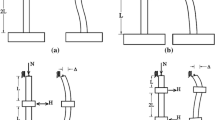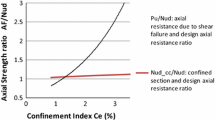Abstract
The use of high-strength concrete (HSC) instead of normal-strength concrete (NSC) in columns has the advantage of allowing the column size to be reduced and is thus becoming popular. However, since HSC is more brittle than NSC, its use could result in undesirable brittle failure. To evaluate the ductility of columns, nonlinear moment–curvature analysis taking into account the stress-path dependence of the steel reinforcement is required. Based on such analysis, a parametric study has been conducted to investigate the effects of various factors on the ductility of columns. The results revealed that the effect of concrete strength is dependent on the axial stress level (axial load to area ratio) and axial load level (axial load to capacity ratio). At the same axial stress level, the use of HSC has little or basically no adverse effect on the ductility but if the same axial load level is maintained to reduce the column size, the use of HSC would significantly reduce the ductility. Finally, two formulas for direct evaluation of the ductility of columns are developed.










Similar content being viewed by others
Abbreviations
- A g :
-
Area of column section (A g = bh)
- A s :
-
Total area of longitudinal steel reinforcement
- A sb :
-
Area of balanced steel reinforcement
- A sc :
-
Area of compression steel reinforcement
- A st :
-
Area of tension steel reinforcement
- b :
-
Breadth of column section
- d i :
-
Depth to centroid of steel at ith layer from extreme compressive fibre
- d n :
-
Depth to neutral axis
- E c :
-
Elastic modulus of concrete
- E s :
-
Elastic modulus of steel reinforcement
- h :
-
Total depth of the column section
- M p :
-
Peak moment
- P :
-
Axial load applied at centroid
- (P/A g f co ) b :
-
Balanced axial load level
- f co :
-
Peak stress on stress–strain curve of concrete
- f ci :
-
Stress at inflection point on descending branch of stress–strain curve
- f cu :
-
Cube strength of concrete
- f y :
-
Yield strength of steel reinforcement
- ε c :
-
Strain in concrete
- ε co :
-
Strain at peak stress on stress–strain curve of concrete
- ε ci :
-
Strain at inflection point on descending branch of stress–strain curve
- ε ps :
-
Residual plastic strain in steel reinforcement
- ε s :
-
Strain in steel
- ϕ :
-
Curvature of column section
- ϕ u :
-
Ultimate curvature
- ϕ y :
-
Yield curvature
- μ :
-
Curvature ductility factor
- ρ :
-
Longitudinal steel ratio (ρ = A s /A g )
- σ c :
-
Stress in concrete
- σ s :
-
Stress in steel reinforcement
References
Priestley MJN, Park R (1987) Strength and ductility of concrete bridge columns under seismic loading. ACI Struct J 84(1):61–76
Dutta A, Mander JB (2001) Energy based methodology for ductile design of concrete columns. J Struct Eng 127(12):1374–1481. doi:10.1061/(ASCE)0733-9445(2001)127:12(1374)
Park R (2001) Improving the resistance of structures to earthquakes. Bull N Z Natl Soc Earthq Eng 34(1):1–39
Pam HJ, Kwan AKH, Islam MS (2001) Flexural strength and ductility of reinforced normal- and high-strength concrete beams. Proc Instit Civ Eng Struct Build 146(Nov):381–389
Ho JCM, Pam HJ (2003) Inelastic design of low-axially loaded high-strength reinforced concrete columns. Eng Struct 25(8):1083–1096. doi:10.1016/S0141-0296(03)00050-6
Park R, Paulay T (1975) Reinforced concrete structures. Wiley, New York, USA, p 769
Kwan AKH (1999) Development of high strength self levelling concrete for Hong Kong. Trans Hong Kong Inst Eng 6(1):6–10
Kwan AKH (2000) Use of condensed silica fume for making high-strength, self-consolidating concrete. Can J Civ Eng 27(4):620–627. doi:10.1139/cjce-27-4-620
Ho JCM, Kwan AKH, Pam HJ (2003) Post-peak flexural behaviour of normal- and high-strength concrete beams. Struct Des Tall Spec Build 12(2):109–125. doi:10.1002/tal.216
Pam HJ, Kwan AKH, Ho JCM (2001) Post-peak behavior and flexural ductility of doubly reinforced normal- and high-strength concrete beams. Struct Eng Mech 12(5):459–474
Kwan AKH, Ho JCM, Pam HJ (2004) Effects of concrete grade and steel yield strength on flexural ductility of reinforced concrete beams. Aust J Struct Eng 5(2):119–138
Kwan AKH, Chau SL, Au FTK (2006) Design of high-strength concrete beams subjected to small axial loads. Magn Concr Res 58(6):333–341. doi:10.1680/macr.2006.58.6.333
Ho JCM, Pam HJ (2002) Flexural strength and ductility performance of high-strength reinforced concrete columns. Struct Eng 80(23/24):26–34
Ho JCM, Kwan AKH, Pam HJ (2004) Minimum flexural ductility design of high-strength concrete beams. Magn Concr Res 56(1):13–22. doi:10.1680/macr.56.1.13.36291
Attard MM, Setunge S (1996) The stress strain relationship of confined and unconfined concrete. ACI Mater J 93(5):432–442
ACI Committee 318 (2005) Building code requirements for reinforced concrete and commentary, manual of concrete practice, ACI 318M-05. American Concrete Institute, Michigan, USA, p 436
Ibrahim HHH, MacGregor JG (1997) Modification of the ACI rectangular stress block for high-strength concrete. ACI Struct J 94(1):40–48
Ho JCM, Kwan AKH, Pam HJ (2002) Ultimate concrete strain and equivalent rectangular stress block for design of high-strength concrete beams. Struct Eng 80(16):26–32
Ho JCM, Pam HJ (2003) Influence of transverse steel configuration on post-elastic behaviour of high-strength reinforced concrete columns. Trans Hong Kong Inst Eng 10(2):1–9
Author information
Authors and Affiliations
Corresponding author
Rights and permissions
About this article
Cite this article
Lam, J.Y.K., Ho, J.C.M. & Kwan, A.K.H. Flexural ductility of high-strength concrete columns with minimal confinement. Mater Struct 42, 909–921 (2009). https://doi.org/10.1617/s11527-008-9431-5
Received:
Accepted:
Published:
Issue Date:
DOI: https://doi.org/10.1617/s11527-008-9431-5




